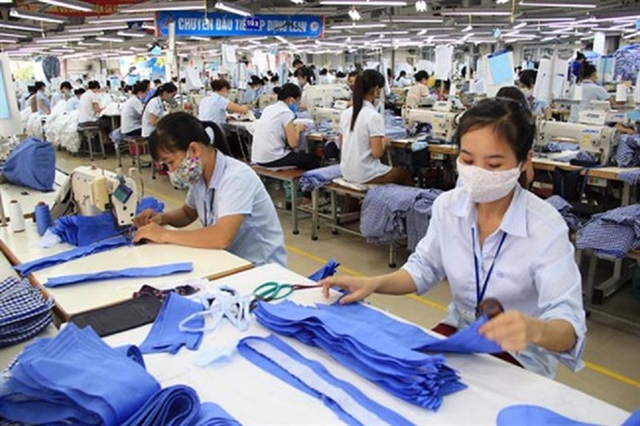 Economy
Economy


|
| Workers at a textile factory. VITAS said six-month textile exports reached $22.3 billion. — Photo vneconomy.vn |
HÀ NỘI — In contrast to a sector-wide pickup in the first quarter of 2022, textile firms saw mixed performance in the second quarter.
According to the Vietnam Textile and Apparel Association (VITAS), textile exports hit around US$22.3 billion in the first six months of the year, up 17.7 per cent compared to the same period last year.
The Vietnam National Textile and Garment Group (Vinatex) made an after-tax profit of VNĐ573 billion ($25 million) in Q2, up 49 per cent compared to Q2/2021.
The firm attributed the rise in profit to its high volume of cotton in storage, which resulted in low production costs amid mounting cotton prices.
The TNG Investment and Trading JSC followed suit with a revenue of nearly VNĐ2 trillion and after-tax profit of VNĐ87 billion, up 35.7 per cent and 42.3 per cent year-on-year, respectively.
The Phong Phú Corporation was another firm that came out well in Q2. It raked in over VNĐ160 billion in profit, surpassing the figure in Q2/2021 by 11 per cent.
Although many firms were riding high in the second quarter, some others saw their profits eroded by rising costs.
The Thành Công Textile Garment Investment Trading JSC earned just VNĐ55 billion in Q2, down 6 per cent against Q2/2021. The company said higher overheads and exchange rate fluctuations cost it over VNĐ75 billion, eating into its profits.
The situation was not better for the Century Synthetic Fiber Corporation as the company saw a fall of 2 per cent in profit due to soaring financial costs. The costs ballooned from VNĐ320 million to over VNĐ15 billion, driving its profits down to VNĐ69.4 billion.
The Hanoi Textile Garment JSC ran unprofitably as it incurred higher financial costs and elevated costs of sales. It made a loss of VNĐ5.4 billion in Q2, a stark contrast to the profit of VNĐ6.2 billion in the same period last year.
VITAS said the outlook of Vietnamese textiles is not very optimistic in the second half of the year as the risk of COVID-19 resurgence is still high.
On top of that, many of Việt Nam's commercial partners have been tightening up their preventive measures against COVID-19, fuelling the situation.
Rising inflation in textile-importing countries, coupled with the prolonged Ukraine-Russia conflict, would continue to push up materials and fuel prices, adding around 25 per cent to textile firms' bills and eroding their profits.
The securities firm SSI forecast that textile firms would fare worse financially in the last six months of 2022 and early 2023.
It is the case because rising costs, including labour, material and logistic costs, and the possible downturn of the US economy, a major textile importer, are expected to wear away their earnings.
The Việt Dragon Securities believed that textile demand would fall during the rest of year as consumers have begun to tighten their belts and cut back on non-essential products.
It forecast that domestic textile firms would have to compete more vigorously for input materials and sale contracts during the period. Big firms are more likely to fare better profit-wise since they have a solid customer base. — VNS




